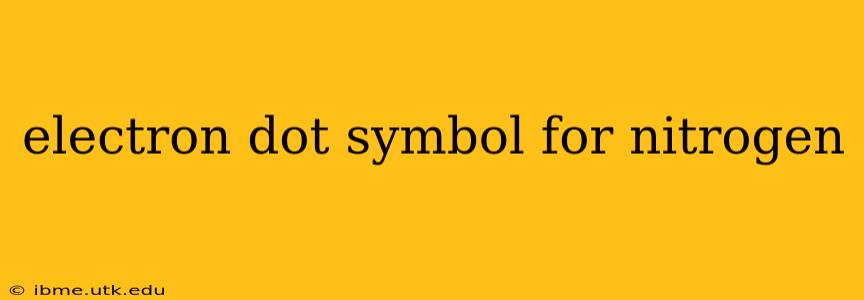The Electron Dot Symbol for Nitrogen: A Deep Dive
Nitrogen, a crucial element for life as we know it, boasts an intriguing electron configuration reflected in its electron dot symbol. Understanding this symbol is key to comprehending nitrogen's chemical behavior and its role in forming various compounds. This article will explore the electron dot symbol for nitrogen, explaining its construction and implications.
What is an Electron Dot Symbol (Lewis Dot Structure)?
Before diving into nitrogen specifically, let's define what an electron dot symbol is. It's a simple visual representation of an atom's valence electrons – the electrons in its outermost shell that participate in chemical bonding. These electrons are represented by dots placed around the element's symbol. The number of dots equals the number of valence electrons.
How Many Valence Electrons Does Nitrogen Have?
Nitrogen's atomic number is 7, meaning it has 7 protons and 7 electrons. Its electron configuration is 1s²2s²2p³. This means it has two electrons in the first energy level (1s²), two in the second energy level (2s²), and three in the 2p sublevel (2p³). Only the electrons in the outermost shell (the second energy level in this case) are considered valence electrons. Therefore, nitrogen has 5 valence electrons.
Drawing the Electron Dot Symbol for Nitrogen
Now that we know nitrogen has 5 valence electrons, we can construct its electron dot symbol:
•
N •
• •
The "N" represents the nitrogen atom. The five dots surrounding it represent its five valence electrons. While the arrangement of the dots isn't strictly prescribed, it's common practice to place them individually on the four sides of the symbol before pairing them up. This arrangement reflects the orbitals in which the valence electrons reside, although this level of detail is not always necessary.
Why is the Electron Dot Symbol Important?
The electron dot symbol is crucial for several reasons:
-
Predicting Chemical Bonding: It helps predict how an atom will bond with other atoms. Nitrogen, with its five valence electrons, tends to form three covalent bonds to achieve a stable octet (eight electrons in its outer shell). This explains why nitrogen often forms compounds like ammonia (NH₃) and nitrogen trichloride (NCl₃).
-
Understanding Chemical Reactions: It provides a simplified visual of how electrons are involved in chemical reactions, making it easier to understand the mechanisms behind bond formation and breakage.
-
Illustrating Molecular Geometry: While not directly showing the geometry, the placement of dots can hint at the likely arrangement of atoms in a molecule.
What are some common nitrogen compounds?
Nitrogen's electron configuration explains its prevalence in various crucial compounds. Some examples include:
- Ammonia (NH₃): Used in fertilizers and cleaning products.
- Nitric acid (HNO₃): Used in the production of fertilizers and explosives.
- Nitrous oxide (N₂O): A greenhouse gas also used as an anesthetic.
- Proteins and Nucleic Acids: Nitrogen is a fundamental building block of proteins and nucleic acids (DNA and RNA), essential for life.
How does the electron dot structure of nitrogen help us understand its properties?
The electron dot structure directly relates to nitrogen's chemical properties. Its five valence electrons explain its reactivity, its tendency to form three covalent bonds, and its ability to exist in various oxidation states. This understanding is crucial in various fields, including chemistry, biology, and environmental science.
This detailed explanation of nitrogen's electron dot symbol should provide a comprehensive understanding of this fundamental concept in chemistry. Remember, the electron dot symbol, though simple, is a powerful tool for understanding chemical bonding and reactivity.
